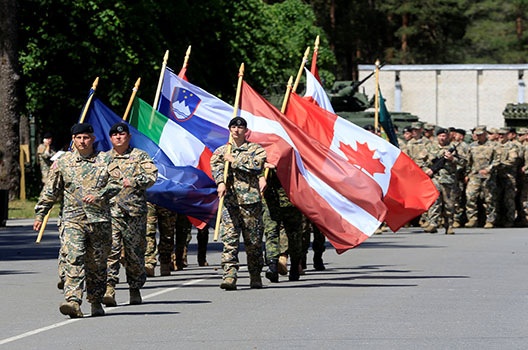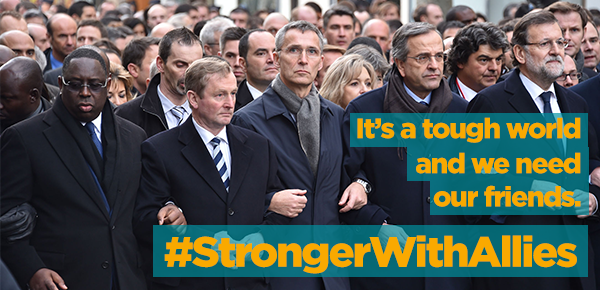US President Donald J. Trump sent ripples through the transatlantic community after sending letters to NATO allies demanding that they spend more on their own defense. Trump’s stance appears to stem from the belief—shared by many in the United States—that European allies have long taken advantage of American military protection without making a fair contribution to common security. This view rests on the assumption that the United States is paying for European defense and receiving nothing in return.
As the Atlantic Council’s Magnus Nordenman and the Center for Transatlantic Relations’ Hans Binnendijk write in their issue brief, NATO’s Value to the United States: By the Numbers, however, this is far from the case. Here is what they listed as the key benefits the United States gets from NATO:
NATO promotes peace within Europe and deters major US adversaries from launching large-scale conventional wars.
- World War II cost the United States more than 400,000 lives and an estimated $4.1 trillion (in 2011 dollars). NATO has been key to preserving peace within the European continent and preventing other adversaries from launching a major conventional war.
- According to credible sources, a major conventional war today could cost the United States upwards of $2.5 trillion per year.
- NATO also promotes the American values of democracy and rule of law. Twenty-six of the twenty-nine NATO member states were labelled as “free” by Freedom House in 2018. By comparison, just 39 percent of the world’s population lives in “free” countries.
NATO is a force multiplier that gives the United States access to military tools in greater numbers than it can achieve by itself.
- Non-US NATO members have 1,857,000 active duty service members and 1,232,290 reservists. The seven largest non-US NATO member armies have the same number of active duty troops as the United States (1.3 million).
- Non-US NATO members can deploy 6,983 battle tanks, 34,000 armored vehicles, 2,600 combat aircraft, 382 attack helicopters, 252 major naval craft (including submarines), and 1,582 patrol and surface combatants.
- France and the United Kingdom alone provide 30 percent of the Alliance’s ballistic-missile-submarine fleet.
- NATO’s European members are beginning to host the first stages of the Alliance’s new ballistic-missile-defense system aimed at preventing long-range attacks by rogue states on the United States and Europe.
- NATO members frequently share intelligence across the Alliance, aiding US operations and intelligence-gathering. The United Kingdom, France, and Germany alone add 40,000 intelligence personnel to the Alliance’s intelligence capabilities.
- Non-US NATO members host twenty-eight US main operating bases in Europe, which cut down on the time needed for the United States to respond to a crisis and are critical for US missions in the Middle East and North Africa.
- In 2009, for example, Germany contributed $800 million to offset and improve its US bases.
NATO undertakes numerous missions to protect member states and promote security around the globe.
- NATO has five active missions around the world deploying 18,000 troops.
- Since the end of the Cold War, NATO has completed thirteen missions including two in the United States (Hurricane Katrina relief and post-9/11 air reconnaissance patrol).
- NATO allies contributed thousands of troops to the International Security Assistance Force in Afghanistan, including 38,000 in 2011, saving the United States an estimated $49 billion that year. The operation in Afghanistan was the first and only time NATO’s mutual defense commitment was invoked.
- Non-US members sustained more than 1,000 combat deaths in Afghanistan, with an additional one hundred lost by NATO partners.
- Non-US NATO members contributed more than 60 percent of assets for Operation Unified Protector in Libya.
- Non-US Coalition members flew one-third of all coalition airstrikes against the Islamic State of Iraq and al-Sham (ISIS) in Operation Inherent Resolve.
- NATO’s Operation Ocean Shield against piracy in the Gulf of Aden has been led at different times by Denmark, Spain, Norway, Italy, the Netherlands, the United Kingdom, and Portugal.
NATO supports and protects the economies of Europe, which are critical to the health of the US economy.
- US trade with the European Union reached $699 billion in 2015, only made possible because of the security and stability provided by NATO.
- US exports to the former Communist NATO member states (not including East Germany) grew from $0.9 billion in 1989 to $9.4 billion in 2016.
- Non-US NATO members rely heavily on the US defense industry to supply their forces. Currently, European members are planning to purchase as many as 500 new F-35s from the United States.
To read more about these points in detail, see the full report from Hans Binnendijk and Magnus Nordenman here: http://www.atlanticcouncil.org/publications/issue-briefs/nato-s-value-to-the-united-states-by-the-numbers.
David A. Wemer is assistant director, editorial, at the Atlantic Council. You can follow him on Twitter @DavidAWemer.
The Atlantic Council is supporting the #StrongerWithAllies campaign, promoting the idea that the United States is stronger and safer with friends abroad. Please join our effort by visiting StrongerWithAllies.org and using our social media toolkit to share your own content about why we’re #StrongerWithAllies.
Image: Soldiers hold their national flags during the official welcoming ceremony of the NATO Canadian-led Enhanced Forward Presence (EFP) combat battalion in Adazi, Latvia June 19, 2017. (REUTERS/Ints Kalnins)

